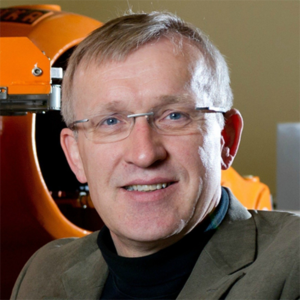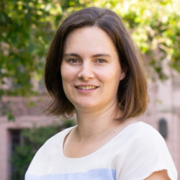CCC at AAAS 2022
The Computing Community Consortium (CCC) has attended and hosted sessions at the American Association for the Advancement of Science (AAAS) Annual Meeting since 2013. To learn more about the 2022 AAAS Meeting visit the webpage.
Robotics: Empowering not Replacing People
Friday, February 18th, 1:00 – 1:45 PM ET
Synopsis: Robotics empowers people by increasing productivity, which drives prosperity. However, the public perception is that robots will take jobs away from humans and that robots will take control of the world. The speakers will address this misconception and provide data that show how increases in investments in robotics produce new jobs. Those new jobs are not only for the maintenance of the robots, but for their design, manufacture, and development of novel applications. The jobs will require novel technical skills and make the work available to humans more creative and rewarding than the jobs displaced by the robots while increasing the safety of the workers. Many areas of the economy already rely on robots, but there are new opportunities. In addition to manufacturing, e-commerce relies extensively on robots to handle warehouses and distribution centers. Agriculture is relying on robots to increase productivity and reduce food cost. Improving the quality of life for the aging population is a major societal need, where robots can provide support and companionship to people who live alone and have no access to other social interactions.
Speakers:

Henrik Christensen
University of California, San Diego
Empowering People Using Robot Technology
Over the past few decades there has been tremendous growth in adoption of robots. An early fear was that robots would take away jobs from people. It is now evident that adoption of robots is correlated with growth in jobs. The presentation will discuss the results of a careful study on how robots assist people in daily lives from manufacturing, over services to security and logistics. It will cover results over a ten-year period to ensure trends beyond short-term market fluctuations.

Michelle Johnson
University of Pennsylvania
Rehabilitation Robotics Can Help Bridge Gaps in Strike Rehabilitation Care
This presentation will discuss the use of robots in the care of stroke rehabilitation and the observed benefits, cost, and challenges to the implementation of them with special attention paid to the use of robots to support existing jobs of caregivers and clinicians, especially in poor resource settings, as well as to create new ones.

Julie Shah
Massachusetts Institute of Technology
Human-Robot Collaboration and the Future of Team Performance
People who excel at finding solutions to complex problems may outperform the most sophisticated algorithms, but often cannot say how they do it. Similarly, machines cannot explain their work. This presentation discusses computational models that enable machines to infer the mental state of human teammates. The studies demonstrate statistically significant improvements in people’s performance on military, health care, and manufacturing tasks, when aided by intelligent machine teammates.
Moderator:

Maria Gini
University of Minnesota
Speaker Slides
- Henrik Christensen – Empowering People
- Michelle Johnson – Rehab Robotics Can help Bridge Gaps in Stroke Care
- Julie Shah – Intelligent Machine Teammates
Intelligent Infrastructure For All: Challenges and Opportunities
Friday, February 18th, 2:00 – 2:45 PM ET
Synopsis: It is increasingly evident that the United States must make major investments to renew and enhance rural and urban infrastructures for economic competitiveness, resilience to natural disasters, sustainability, and social justice goals. Since infrastructure investments have very long lifetimes, the choices made today are critical for the future. Beyond the more traditional forms of physical infrastructure, intelligent infrastructure is the embedding of sensing, computing, and communications capabilities into projects such as roads, buildings, and bridges, along with a wide range of techniques to assemble and analyze the data produced to make it useful. Intelligence embedded in infrastructure not only provides greater efficiencies and significant cost savings, it can also serve as the foundation for achieving resiliency, equity, and prosperity for rural and disadvantaged urban communities. However, there are risks such as increased surveillance. Thus, research is still needed in computing and other related disciplines to move toward realizing these goals. This scientific session will provide overviews of several compelling opportunities. These include new transportation planning processes and policies aimed toward resilient and sustainable urban transportation systems; modernizing the U.S. physical assets from both the public and private sectors; and convergent cyber-physical systems that address multiple critical societal issues.
Speakers:

Megan Ryerson
University of Pennsylvania
Transforming Transportation with Intelligent Infrastructure
Intelligent infrastructure can provide fine-grained data and analytics for transportation to improve accessibility, sustainability, and resilience. The fine-grain data supports real-time dashboards with maps and performance indicators such as travel time and cost to work, education, and health to help citizens choose among travel options. It also helps policymakers compare future plans to reduce inequality in access to transportation across neighborhoods.

Adie Tomer
Brookings Institution
Modernizing the Country’s Physical Assets
The United States’ infrastructure networks are now crumbling, but the public and private sectors are not yet planning and investing in ways that will maximize shared prosperity. Modernizing the country’s physical assets will first require a new direction. If executed well, a new set of outcomes can initiate a new approach to infrastructure investment, one that prioritizes advanced materials, data-informed design and construction, and cutting-edge performance indicators to build a better world.

Chandra Krintz
University of California, Santa Barbara
Convergent Cyber-Physical Systems
Intelligent infrastructure combines remote and in situ sensing with statistical analysis, physical modeling, and machine learning and artificial intelligence. This presentation discusses recent advances in cyber-physical systems that are “convergent”, i.e., they converge the sensing and actuation technologies from The Internet of Things with support infrastructure and autonomy technologies.
Speaker Slides
- Megan Ryerson – Safe and Equitable by Design: Data-driven Methods are Needed to Integrate the Traveler Perspective into Transportation System Design
- Adie Tomer – Rebuilding American Infrastructure for 21st Century
- Chandra Krintz – Research Building Blocks for Intelligent Infrastructure: Convergent Systems
Narratives, Tech, and Countering Disinformation
Sunday, February 20th, 2:00 – 2:45 PM ET
Synopsis: The increased prevalence of disinformation and conspiracy theories in society poses a challenge to policymakers, institutions, scientists, and the United States’ ability to respond to grand challenges like the COVID-19 pandemic. When public trust in institutions is low, countering disinformation with facts can often fail. As a follow-on to the successful scientific session “Detecting, Combating, and Identifying Dis- and Mis-information” at the 2020 AAAS Annual Meeting, this session will explore the roles stories and narrative framing play in both propagating and countering disinformation, and how technological solutions must be coupled with sociological interventions to effectively address the issue. This session brings together experts from computer science, social science, industry, and government to discuss why some groups have proven so resistant to fact-based arguments and continue to adhere to provably false beliefs, and how to penetrate that resistance to communicate accurate information.
Speakers:

Scott Ruston
Arizona State University
Getting Beyond the Bots: Analyzing and Mitigating Impact of Disinformation
Disinformation assaults political will, manipulates public opinion, and erodes sociopolitical institutions. Reducing disinformation to a solely technical problem overlooks key mechanisms of disinformation. Responding to the threat requires interdisciplinary research that leverages computer science along with social science and humanities insights in order to develop more scalable solutions built on societal resilience.

Chris Bregler
Manipulated Media, Context Retargeting, and Misinformation Mitigation
Over the past years, research breakthroughs in photorealistic synthesis techniques have opened up new possibilities for societally beneficial uses, but also created concerns about misuses, especially for disinformation campaigns. Examples are based on so-called deepfakes and cheap fakes. This talk covers some of Google’s efforts in the area of mitigating these new threats and also surveys the landscape more broadly.

Emma Spiro
University of Washington
Online Communication in the Context of Emergencies and Disaster Events
Misinformation is a prominent feature of our information landscape, as evident in the 2020 US election and the COVID-19 pandemic. In this talk, I review work exploring “repeat offenders” of misinformation. The talk is based on participation in a coalition focused on supporting real-time information exchange between the research community and other stakeholders. Our objective in these rapid response efforts is to detect and mitigate misinformation and disinformation narratives.
Moderator:

Nadya Bliss
Arizona State University
Speaker Slides
- Emily Spiro – Disinformation Repeat Offenders: Case of the 2020 US Election
- Scott Ruston – Getting Beyond the Bots: Understanding Disinformation
- Chris Bregler – Detecting, Combating and Identifying Dis- and Mis-information
Assured Autonomy: A Socioeconomic-Technical Opportunity and Challenge
Sunday, February 20th, 3:00 – 3:45 PM ET
Synopsis: The future is in the partnerships people form with machines. Since the mid-20th century, machine intelligence has started to match or better human intelligence. People are no longer equal partners with technology. The human has been moved out of the driver’s seat and out of the cockpit, trusting technology to follow instructions while advising and protecting. The driverless car is so compelling that companies, governments, and societies are rushing to create new partnerships despite the inability to answer the simplest yet most important of questions, such as “is it safe?” With assured autonomy, so that every car, truck, ship, and aircraft was fully autonomous, the transportation industry could be transformed by making it more capable and resilient to disruptions. However, public policy, legislation, and regulation are lagging. COVID-19 has changed decision calculus about the importance of autonomous systems, but autonomy requires assurances. Appropriate assurances for future autonomous systems require a common ground in the crossing of multiple disciplines including but not limited to engineering, computer science, artificial intelligence, human factors, communication, cognitive science, business, law, ethics, and public policy. The proposed session will reflect on the future of autonomy and the role of assured autonomy in realizing the socioeconomic-technological opportunities and coping with the associated challenges.
Speakers:

Robin Murphy
Texas A&M University
Assured Autonomy for Disaster Management
Disaster management, from pre-disaster mitigation to response and recovery, could benefit from artificial intelligence and robotics. However, models of how emergency professionals adopt innovation indicate that there are two major influences: the trustworthiness of the package, device, or system to operate reliably in a new incident and the usability of the system without incurring significant negative secondary effects on work processes.

David Danks
University of California, San Diego
From Values to Constraints to Assurance
Autonomy is required when people cannot say in advance exactly how a system should behave. People do, however, typically know the values and interests that should be advanced by the autonomous system. The challenge is to translate these values into constraints on the technology, social structures, and regulations to establish some degree of assurance that the system will do “what we want.” This talk will argue that this challenge is partly solvable through highly interdisciplinary efforts.

Eric Wolff
Motional
Challenges in Assured Autonomy for Self-Driving Cars
In the not-too-distant future, people will be sharing the road with self-driving cars. These vehicles increasingly rely on machine learning (ML) models to perceive the world around them, predict what other road users will do, and plan safe and comfortable actions. A major challenge is ensuring that these ML-based cars drive with reliability matching or exceeding a human driver, as well as convincing policymakers and the public of their safety.
Moderator:
 Ufuk Topcu
Ufuk Topcu
The University of Texas at Austin
Speaker Slides
- Robin Murphy – Assured Autonomy for Disaster Management
- David Danks – From Values to Constraints to Assurance
- Eric Wolff – Challenges in Assured Autonomy for Self-driving Cars







